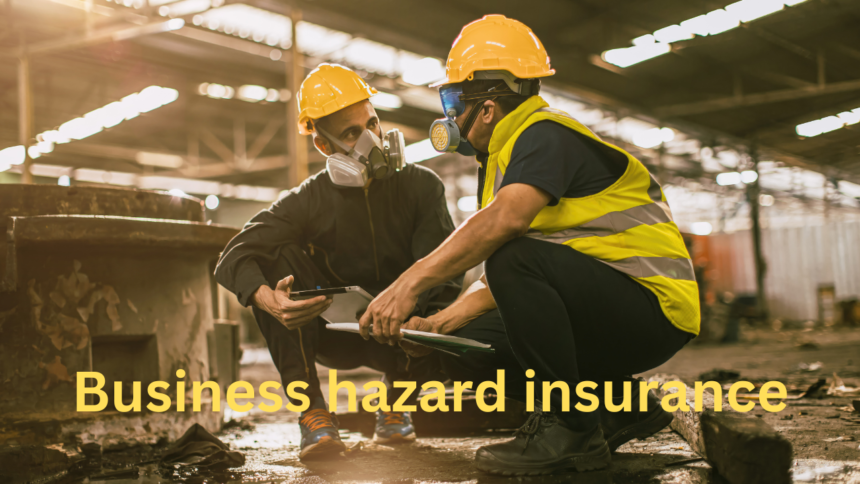Business hazard insurance protects business owners against losses from unexpected events. home insurance safeguards your personal property, and business hazard insurance shelters your commercial property. It ensures losses from disasters like fires, storms or break-ins won’t be costly alone.
Whether you run a small shop or a large corporation, commercial insurance is important. It keeps your business secure. Without coverage for losses, one problem could destroy your work. Business hazard insurance offers peace of mind with a safety net for disasters. It lets you focus on growth without worrying about risks to stability.
This article explains business hazard insurance and why it’s important. It will find the best options to fit you. Learning about this resource could save money down the road. Read on to ensure coverage for damages or theft to your business.
Businesses hazard insurance For home-based Businesses
Many small home businesses work from a spare room or garage. Home insurance covers the house. It does not always protect work things like equipment, supplies, or furniture used each day. For a low price, home business owners feel safe knowing their work money and way to make money stay covered if something bad happens.
Cost of business insurance
The cost to insure work properties depends on what business owners send on forms. Companies see these details like the size and age of the building, risks from floods or fires in the area, the total value of work items, and safety steps used. On average in the United States, monthly premiums for property insurance cost between $50 to $100. But prices may be lower or higher depending on each business’s risk.
Insurance for a Small Business Administration (SBA) Loan
Most lenders require insurance on properties they lend money for so items stay protected. This includes Small Business Administration loans offered to help growing businesses. As part of asking for a loan, you must show proof of insurance on buildings and things the loan pays for. This makes sure tax money stays protected if bad things damage them before the loan is repaid. Business owners get approved loans when meeting all terms including insurance now.
What Does Business Hazard Insurance Cover?
Whether you run a small storefront or a large factory, it is important to understand what exactly your business hazard insurance policy protects. These policies are designed to protect properties from unexpected incidents that could severely impact business operations. Some of the key risks covered typically include:
- Fire
- Theft
- Storms
- Vandalism
- Power outages
- Floods (optional)
Why SBA Require Hazard Insurance for EIDL Loans?
The SBA wants assurances that loan funds are protected from property loss. If a business suffers damage without coverage, it may struggle to repay the loan. Business hazard insurance gives reassurance that even if insured disasters strike, loan collateral remains protected. This allows the SBA to continue supporting small businesses to recover and repay taxpayers over time. The requirement also encourages responsible, low-risk lending that benefits both businesses and American economic growth.
With hazard coverage in place, business owners can use EIDL loans focusing on recovery, not property repairs. Claims provide repair dollars so operations restart smoothly. This upholds the SBA mission of stabilizing communities during disasters and assisting small firms’ vital roles. Insurance gives confidence funds contribute as intended through difficult times.
Who needs small business hazard insurance?
Most businesses that own or rent facilities require hazard coverage due to risks. They contain inventories, equipment, or other assets in buildings endangered by issues like fires and floods. While costs vary, the security outweighs premiums for many small companies.
Home-based businesses also face property threats, though homeowners’ policies limit asset coverage. Without supplemental hazard plans, losses could incapacitate these ventures. Other businesses like manufacturers using expensive machinery or distributors handling products also rely on insurance restoration after losses. For a small monthly fee, they earn financial protection ensuring stability through unexpected challenges.
Steps to Get hazard insurance
Step 1: Decide What to Cover
Take inventory of all business property like equipment, supplies, and furniture. Note purchase costs to estimate coverage needed. Include business structure if renting space.
Step 2: Research Insurance Providers
Check with independent agents or compare rates online from multiple carriers. Read reviews to find reputable insurers suited to your industry.
Step 3: Apply for a Quote
Supply business details, property values, and location when requesting quotes. Carriers assess risk to give personalized premium estimates.
Step 4: Compare Quotes
Look at price, coverage amounts, and policy fine print. Select an insurer offering necessary protection within budget. Ask agents questions to understand options.
Step 5: Review Policy Details
Understand exactly what is and isn’t covered by the chosen policy. Note deductible amounts for filing claims. Ask about additional customizing options if needed.
Step 6: Sign and Pay
Finalize purchase by signing contract, and making initial payment. Mark your insurance ID for quick access if disaster strikes your business assets or property.
FAQ’s
What Types of Insurance Does a Small Business Need?
Small businesses often need hazard insurance and general liability insurance. It’s also common for small companies to have worker’s compensation and professional liability coverage.
Can you have hazard insurance if you don’t own commercial property and work out of your home?
Yes, if you run a business from home, you can purchase hazard insurance to cover business equipment and supplies. Your homeowner’s policy may not cover business property losses.
Is hazard insurance the same as general liability insurance?
No, hazard insurance covers damage to business property from events like fires and floods. General liability insurance protects against claims from injuries on your property or faults with products.
What are the three types of hazard insurance?
The main three types of hazard insurance are property insurance, business interruption insurance, and flood insurance. The property covers buildings and assets, business interruption pays with forced closure, and flood insurance protects high-risk flood areas.
Final Thoughts
Business hazard insurance gives important protection. It protects company property and supplies. It protects the buildings small businesses use. It protects equipment, stock, and supplies for work. Getting this coverage lets business owners feel safe. Their way of making money and investments is protected from fires, storms, or theft. Following easy steps find a policy. It offers protection without high costs. It shelters companies from financial trouble when bad things happen. Knowing choices and what lenders need lets small businesses make wise decisions.







